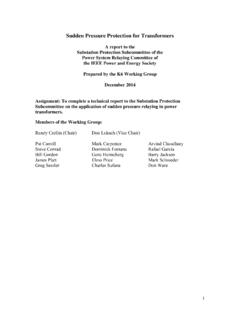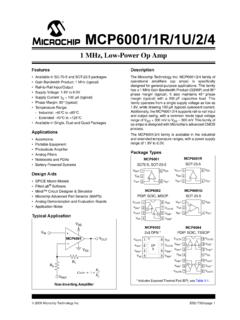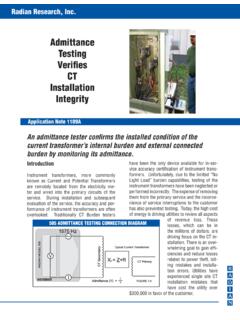Transcription of Practical Aspects of Rogowski Coil Applications to Relaying
1 September 2010. Special Report Practical Aspects of Rogowski Coil Applications to Relaying Sponsored by the Power System Relaying Committee of the IEEE Power Engineering Society Working Group members: Practical Aspects of Rogowski Coil Applications to Relaying Table of Contents Assignment ..5. Abbreviations and Acronyms ..6. Theory of Operation ..7. Gapped-Core Current Transformers ..12. Linear Couplers ..12. Comparison of V-I Characteristics ..13. Rogowski Coil Designs ..13. Transient Response ..22. Frequency Response ..24. Rejection of External Electromagnetic Fields ..25. Review of Rogowski Coil Characteristics ..26. Accuracy 26. Linearity (No Saturation) 26. No Accuracy versus Burden Calculation 26. Size 26. Weight 27. Safety 27. Simplified Ordering 28.
2 Improved Switchgear Design and Performance 28. Environmental Aspects 29. Relay Design Simplification 29. Scale Factor ..30. Standard Accuracy Classes ..31. Metering LPCS 31. Protective low-power stand-alone current sensors 31. Multipurpose ECT ..32. Standard values for rated primary current ..32. Standard values for rated extended primary current factor ..32. Rated continuous thermal current ..33. Standard values of rated secondary voltage ..33. Rogowski Coil Burden ..33. Range of Operation ..33. Low Voltage Application Designs ..35. Energy monitoring ..36. Medium Voltage Application Designs ..36. High Voltage Application Designs ..42. GIS Application Designs ..48. Applications within Low-Voltage Systems ..56. Applications within Medium-Voltage Systems.
3 58. Applications within High-Voltage Systems ..59. Future Protection Application ..59. Traveling Wave-based Protection 59. Differential Protection of Power Transformers ..60. Differential Protection of Power Line/Cables ..66. Physical Maintenance ..69. Accuracy tests ..70. Other tests ..71. 1 Introduction Produce a special report describing Applications of Rogowski Coils used for protective Relaying in electric power systems. Rogowski Coils operate on the same principles as conventional iron-core current transformers (CTs). The main difference between Rogowski Coils and CTs is that Rogowski Coil windings are wound over an (non-magnetic) air core, instead of over an iron core. As a result, Rogowski Coils are linear since the air core cannot saturate.
4 However, the mutual coupling between the primary conductor and the secondary winding in Rogowski Coils is much smaller than in CTs. Therefore, Rogowski Coil output power is small, so it cannot drive current through low-resistance burden like CTs are able to drive. Rogowski Coils can provide input signals for microprocessor-based devices that have a high input resistance; therefore, these devices measure voltage across the Rogowski Coil secondary output terminals. In general, Rogowski Coil current sensors have performance characteristics that are favorable when compared to conventional CTs. These characteristics include high measurement accuracy and a wide operating current range allowing the use of the same device for both metering and protection.
5 This can result in reduced inventory costs since fewer sensors are needed for all Applications . Less variation in inventory requirements should also improve installation time when replacements are needed, reducing equipment downtime; thereby, lowering overall sensor costs to the utility or industrial company. This is achieved through higher unification and standardization of products, which benefits manufacturers and users. In addition, Rogowski Coils make protection schemes possible that were not achievable by conventional CTs because of saturation, size, weight, and/or difficulty encountered when attempting to install current transformers around conductors that cannot be opened. An additional advantage of Rogowski Coil current sensors is significantly lower power consumption during operation.
6 Rogowski Coils are connected to devices that have high input resistance, resulting in negligible current flowing through the secondary circuit. Conventional CTs contain a ferromagnetic core that also consumes energy/power due to hysteresis losses. Rogowski Coils have no core losses. In fact, an operating Rogowski Coil has much smaller power loss than conventional CTs which leads to significant savings of energy and ultimately reduced lifecycle costs. Rogowski Coils can replace conventional CTs for protection, metering, and control. Rogowski Coils have been applied at all voltage levels (low, medium, and high voltage). However, unlike CTs that produce secondary current proportional to the primary current, Rogowski Coils produce output voltage that is a scaled time derivative di(t)/dt of the primary current.
7 Signal processing is required to extract the power frequency signal for Applications in phasor-based protective relays and microprocessor-based equipment must be designed to accept these types of signals. A/D. AIS Air Insulated Switchgear CT Iron-Core Current Transformer CB. DC. EAF. ECT Electronic Current Transformer EVT Electronic Voltage Transformer EIT Electronic Instrument Transformer GIS Gas Insulated Switchgear HV. IED Intelligent Electronic Device IT Instrument Transformer LAN. LPCS. LTC. MU. OPDL. PCB Printed Circuit Board RMS Root Mean Square SU Sensing Unit TW. TWC. TWV. VT. 2 Rogowski Coils Conventional iron-core current transformers (CTs) are typically designed with rated secondary currents of 1 Amp or 5 Amps, to drive low impedance burden of several ohms.
8 Figure 2-1 shows the principle of a CT connection. ANSI/IEEE Standard -2008 [1] specifies CT accuracy class for steady state and symmetrical fault conditions. Accuracy class of the CT ratio error is specified to be 10% or better for a fault current 20 times the CT rated current and up to the standard burden. CTs are designed to meet this requirement. But, if the standard burden is connected to the CT secondary and the RMS value of a symmetric fault current exceeds 20 times the CT rated current or if the RMS value of a fault current is smaller than 20 times the CT rated current but contains DC offset (asymmetric current), the CT will saturate. The secondary current will be distorted and the current RMS value reduced. Traditional Rogowski Coils consist of a wire wound on a non-magnetic core (relative permeability r=1).
9 The coil is then placed around conductors whose currents are to be measured (Figure 2-2). ip(t). n Ip Iron Core (saturable) S. Is m Air Core vs(t). RB (non-saturable). RB. Figure 2-1. Current Transformer Figure 2-2. Rogowski Coil As Rogowski Coils use a non-magnetic core to support the secondary windings, mutual coupling between the primary and secondary windings is weak. Because of weak coupling, to obtain quality current sensors, Rogowski Coils should be designed to meet two main criteria: the relative position of the primary conductor inside the coil loop should not affect the coil output signal, and the impact of nearby conductors that carry high currents on the coil output signal should be minimal. To satisfy the first criteria, mutual inductance M must have a constant value for any position of the primary conductor inside the coil loop.
10 This can be achieved if the windings are: 1) on a core that has a constant cross-section S, 2) perpendicular to the middle line m (dashed line in Figure 2-2 that also represents return wire through the winding), and 3) built with constant turn density n. Mutual inductance M is defined by the formula: M 0 n S. Where 0 is permeability of air. The output voltage is proportional to the rate of change of measured current as given by the formula: dip(t ). vs(t ) M. dt Because the Rogowski Coil primary and secondary windings are weakly coupled (to prevent the unwanted influence from nearby conductors carrying high currents) Rogowski Coils are designed with two wire loops connected in electrically opposite directions. This cancels electromagnetic fields coming from outside the coil loop.









